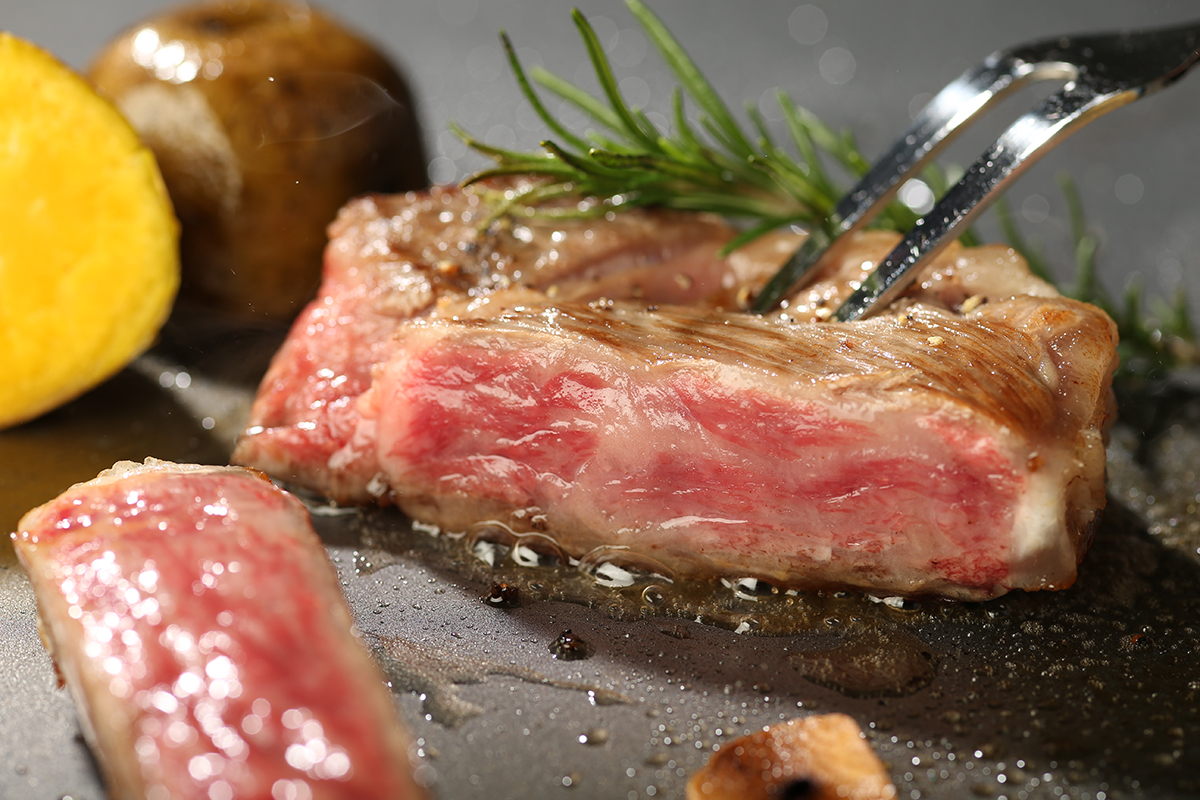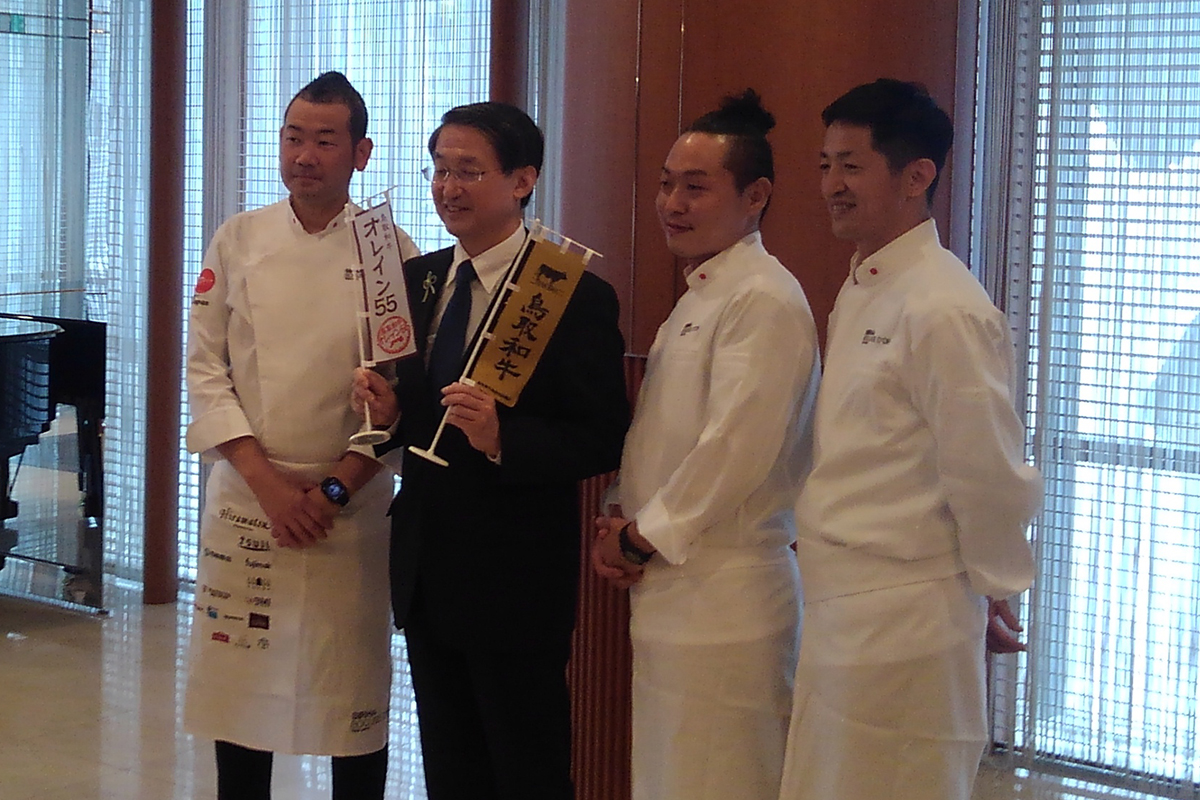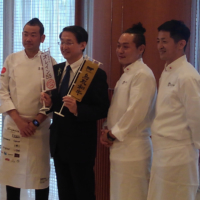Among all the wagyu brands in Japan, Tottori Wagyu Olein 55 is especially flavorful and light because of its high oleic acid content. Oleic acid, the main component of olive oil, is said to enhance the meat’s tenderness and smoothness on the palate. To promote Tottori Wagyu brands, including Tottori Wagyu Olein 55, the prefecture held a gala event on Oct. 25 at Argento, a contemporary French restaurant in Tokyo’s Ginza area, in collaboration with the renowned international culinary competition Bocuse d’Or, Argento and Hiramatsu, the hospitality company that runs Argento.
Tottori Gov. Shinji Hirai gave a welcome speech at the gala and introduced the charms of the prefecture’s wagyu. He explained that it was Tottori that launched registration control of wagyu cattle about a century ago to keep track of their bloodlines. Among many kinds of wagyu entered in the registry, Tottori’s Kedaka cattle — which won the first national contest organized by the Wagyu Registry Association in 1966 — became the origin of many of the wagyu brands that are currently produced across the country.
Among the beef cattle categorized as Tottori Wagyu, only about 16% meet certain standards and can be certified as Tottori Wagyu Olein 55. Those standards include oleic acid content of 55% or higher and belonging to the Kedaka bloodline.
The five dishes served at the gala were prepared by three award-winning chefs. Two desserts using pears and persimmons produced in Tottori were the work of Argento. One of the chefs was Tomoyuki Ishii, the sous-chef of Argento and the candidate representing Japan to next year’s Bocuse d’Or international competition in Lyon, France. He said in the opening remarks of the gala that there are many local delicacies in Tottori besides beef, and that shiitake mushrooms named Tottori 115 contributed greatly to his victory in the preliminary contest of the Bocuse d’Or.
Tottori supported this year’s Bocuse d’Or Japan as a sponsor. Gov. Hirai said the significance of supporting the competition lies in the interactions with the talented chefs who have cooperated with in-depth research on ingredients that Tottori provided. “Their perspectives are different from those of the producers. They notice what we don’t, which is a great benefit,” he said. He also emphasized that communication between producers and chefs can provide clues as to how more value can be added to what the producers are growing.
The two other chefs, Hideki Takayama and Noriyuki Hamada, also have in the past been selected as Japanese representatives to Bocuse d’Or. The gala presented the remarkable opportunity to experience a feast prepared by three of the 30 or so Japanese chefs who have ever won the right to participate in the international competition.
Both Takayama and Hamada have connections with Tottori. Takayama, the owner and chef of the recently opened Kobe restaurant Entre Nous, said: “I served my apprenticeship under a chef who was from the Daisen area in Tottori Prefecture. From this experience, I got to know many producers in Tottori who are immensely committed to what they grow.” Hamada, the executive chef of Hoshinoya Tokyo, said he himself is from Sakaiminato, a port city in Tottori.

Although all five dishes contained beef in different ways, there was no heaviness at all. The melting temperature of oleic acid is much lower than the other fatty acids in beef, which is the reason behind the melt-in-your-mouth texture and nongreasiness of Tottori Wagyu Olein 55. The beef and the beef soup went very well with the other ingredients, even the seafood, most of which were also produced in Tottori. The guests also enjoyed a selection of wines and sake made in the prefecture.
At Argento, the Tottori Wagyu Fair will be held until Nov. 20, serving Tottori Wagyu Olein 55 in the main dishes for the lunch and dinner courses presented by Argento’s head chef, Kentaro Suzuki, who is committed to expressing the delights of Japanese ingredients as well as the producers’ passion and the beauty of the places where the foodstuffs come from. Other dishes in the courses consist of various kinds of meat and seafood with flavorful autumn vegetables and fruits.
Dishes made with wagyu from Tottori can also be enjoyed at seven restaurants at The New Otani Tokyo hotel in Chiyoda Ward during a special event featuring Tottori Wagyu as an original wagyu beef brand until Dec. 16. Guests can enjoy the beef not only as steaks but also in a wide variety of Western, Japanese and Chinese dishes such as minced meat cutlets, stew, spaghetti Bolognese, sukiyaki on rice, thinly sliced Tottori Wagyu served on fried udon noodles, and spicy Sichuan-style tofu and ground beef.
Tottori is a member of the Sustainable Japan Network, a group of companies that cooperate with this newspaper in spreading information about sustainability in Japan. You can also be part of the network; visit https://sustainable.japantimes.com/sjnetwork-en for more details.




















With your current subscription plan you can comment on stories. However, before writing your first comment, please create a display name in the Profile section of your subscriber account page.